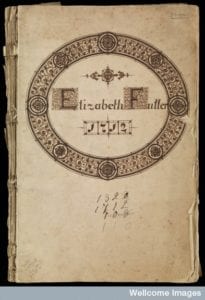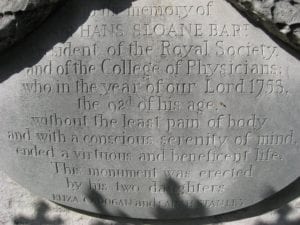
Title page. Vesalius, De humani corporis fabrica libri septum, 1555. Credit: Wellcome Library, London.
Thanks to Felicity Roberts, I’ve learned that a copy of Vesalius’ De Humani Corporis Fabrica Librorum Epitome (Basel, 1543) once owned by Hans Sloane went up for auction at Christie’s on 15 July. Although the list price was a £70,000-£100,000, the book ended up going for £60,000.
Christie’s has just started a Discovery series of short videos to highlight pieces with particularly interesting histories. First up: Sloane’s book! Go take a look at “The ‘Google Maps’ of the Human Body” now.
What I love about this video and post is how well it captures Sven Becker’s enthusiasm when it came to finding something unexpected in the course of researching the book’s provenance. The sale also caused some excitement on the C-18L listserv, with some contributors wondering whether the book had been stolen or its notes forged.
Alison Walker, who leads the British Library’s Sloane Printed Books Project, attended the auction and has been tracing the book’s provenance in more detail. This has required a bit of digging, but the process involved in uncovering a book’s history is fascinating. It’s worth quoting Alison’s findings (which she shared in an email to me) at length. She reports that the book, which was from the Duke of Westminster’s collection,
seems to have been sold as a duplicate by the British Museum in 1769, and appears as lot 336 on p. 12 of S. Baker and G. Leigh, A Catalogue of the Duplicates of the British Museum which will be sold by auction… April 4 1769 and nine following days, London, 1769. Normally one would expect to see a British Museum duplicate sale stamp on the book, but it seems to have been omitted in this case. It is listed on p. 54v of the interleaved copy of J.A. van der Linden, Lindenius renovatus, 1686, which Sloane used as his catalogue of Latin medical books. The book may have been acquired by Sloane in the 1720s or 1730s, though there is no precise acquisition date in his catalogue, and no indication of its previous provenance.
She has now included the book in the Sloane Printed Books database–a useful tool for suggesting the comings and goings of books in Sloane’s library over the years. (And, believe me, it is easy to lose track of time when playing with the database.)
The British Library still holds several other versions of De Humani Corporis Fabrica once owned by Sloane, including an especially fancy Epitome printed on vellum. And along the way, the British Library has sold off other copies from Sloane’s collection. For example, one 1555 edition of the book now at the Royal Society library was purchased during a duplicate sale in 1830.
Although there was a bit of excited speculation about fraud or theft surrounding this sale, a bit of historical detective work can uncover a much more prosaic explanation. Records do sometimes get lost–or never created, as in this case.
The featured image: putti killing a dog, from book 7 of De Humani Corporis Fabrica (Basel, 1555). Credit: Wellcome Library, London. I’ve always hated putti.





